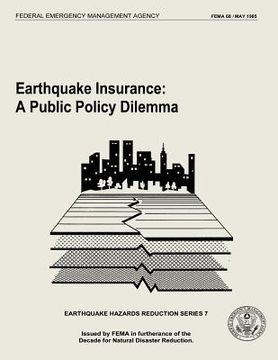Reseña del libro "Earthquake Insurance: A Public Policy Dilemma (FEMA 68) (en Inglés)"
Earthquakes are potentially the most destructive of all natural disasters in both loss of life and property damage. Casualties and structural damage result from intense ground shaking and such secondary effects as fires, landslides, ground subsidence, and flooding from dam collapse or tsunamis. While earthquakes in the United States are commonly associated with the West Coast, particularly California, 39 states altogether face some degree of seismic risk. Seventy million people and at least nine metropolitan areas are susceptible to severe earthquakes. Nevertheless, California has been the focal point of most earthquake studies due to its high frequency of events (two thirds of all earthquakes have occurred in California), large population and extensive property development. But the high frequency of earthquakes alone does not warrant the amount of official and scientific attention these events have received. It is the rare and devastating earthquake such as the 1906 San Francisco quake and the 1964 Alaska event, both of which measured more than 8 on the Richter Scale. Earthquakes of this magnitude could be expected in the United States, and most likely in California, every 60 to 100 years and less severe but major earthquakes every 15 to 20 years (Anderson, et al., 1981). The area currently believed to be at greatest risk of a massive earthquake is the Los Angeles-San Bernardino region. An event which could exceed 8 on the Richter Scale has an estimated annual probability of occurrence of 2 to 5 percent and its likelihood of occurrence in the next 20 to 30 years is regarded as -high". This earthquake could kill and injure between 15,000 and 69,000 persons (depending upon time of occurrence) and cause up to $17 billion in property damage (NSC/FEMA, 1980). Some studies have placed the property damage estimates as high as $50 billion (U.S. Department of Commerce, 1969). This report grew out of the City of Los Angeles Planning Partnership for which the Southern California Earthquake Preparedness Project (SCEPP) was asked to research and report on several issues pertaining to earthquake insurance. In the course of this research, it became obvious to both SCEPP and SCEPP's Policy Advisory Board that earthquake insurance and its role in the recovery process was a major policy issue. Thus, the research effort was expanded to incorporate broader issues and circulation of the report beyond the Los Angeles Planning Partnership. The report has five goals which correspond to its organization: (1) to outline the provisions (coverages, rates, deductibles, etc.) of earthquake insurance policies currently available to the major classes of insurance consumers-homeowners, businesses, local governments and special districts; (2) to determine the extent to which earthquake insurance is purchased by these parties and explore the circumstances surrounding purchase or non-purchase; (3) to review the salient issues in earthquake insurance from the standpoints of purchasers and providers; (4) to explore potential Federal roles in resolving these issues and in providing or promoting earthquake insurance; and finally, (5) to make reasonable policy recommendations involving both the Federal Government and other stakeholders in earthquake insurance toward a more adequate system of coverage.

